

In late 1976 Yamaha launched the new range of SGs this is really the start of a range which encompassed a huge number of models and variations with models appearing vanishing re-appearing with different specs, in fact the whole confusing world of the Yamaha SGs. The models launched are the 500 700 1000 1500 and the 2000 all are 628mms scale 43mm nut 2 volume 2 control and a 3 way switch. I will start with the specs at launch and then move on to talk about individual models.
| Model | 500 | 700 | 1000 | 1500 | 2000 |
| Body | Bound Maple and Agathis | Bound Maple and Mahogany | Bound Maple and Mahogany | Bound T Cross construction Maple and Mahogany | Bound T Cross construction Maple and Mahogany |
| Neck | Mahogany set | Mahogany set | Mahogany Set | Mahogany Set | Mahogany through neck |
| Fretboard | Rosewood chevron markers 22 frets 12” rad | Rosewood chevron markers 22 frets 12” rad | Ebony chevron markers 22 frets 12” rad | Ebony dot markers 22 frets 12” rad | Ebony Chevron markers 22 frets 12” rad |
| Headstock/td> | Yamaha and Thistle type logo model No. on TRC binding 3 gold or amber 2 black lines | Yamaha and Thistle type logo model No. on TRC binding 3 gold or amber 2 black lines | Yamaha and Thistle type logo model No. on TRC binding 3 gold or amber 2 black lines | Yamaha and Thistle type logo model No. on TRC single binding | Yamaha and Thistle type logo model No. on TRC binding 3 gold or amber 2 black lines** |
| Tuners | Yamaha Diecast | Yamaha Diecast | Yamaha High Ratio Diecast | Yamaha Diecast | Yamaha High Ratio Diecast |
| Pickups | Humbucking G-III x 2 exposed | Humbucking G-II x 2 exposed | YAMAHA original "SGH-1SOB" x 2 Alnico Humbuckers exposed* | YAMAHA original "SGH-1SOB" x 2 Alnico Humbuckers exposed* | YAMAHA original "SGH-1SOB" x 2 Alnico Humbuckers exposed* |
| Bridge | Tune O Matic with Stop tail | Tune O Matic with Stop tail | Tune O Matic with Stop tail | Tune O Matic with Stop tail | Tune O Matic with Stop tail |
| Controls | Amber speed dial 2V 2T 3 way no coil split | Amber speed dial 2V 2T 3 way with coil split | Amber speed dial 2V 2T 3 way coil split plus tone bypass circuit | Amber speed dial 2V 2T 3 way no coil split | Amber speed dial 2V 2T 3 way no coil split |
| Hardware | Chrome | Chrome | Gold | Chrome | Gold |
| Weight | 4.4kgs | 4.4kgs | 4.4kgs | 4.4kgs | 4.4kgs |
| Release Price | 50000y | 70000y | 100000y | 150000y | 200000y |
| Colours | Black or Cherry Red | Cherry Sunburst or Brown | Cherry Sunburst or Brown Sunburst | Cherry Sunburst or black | Cherry Sunburst,Cherry, Brown, Black or Brown Sunburst |
*These Alnico V pickups were originally known as OPG-I and OPG-II, the only differences are the OPG-I has gold pole piece
height adjustment screws, while the OPG-II has chrome pole piece height adjustment screws. The OPG-I cost 6,000 yen OEM,
while the OPG-II cost 5,000 yen OEM.
The pickups in the 500 and 700 are the cheaper Yamaha own brand pickups
From 1983 – 1998 some SG-1000, SG-1500 and SG-2000 models were also ordered with the Spinex pickup. Some still with the OPG-I.
Production of Spinex pickups stopped in 1998
This is the basic model but still a very good guitar. Lasted until around 1979. The last mention in a catalogue
I can find is the 1980 UK catalogue. This agrees roughly with the archives. They are reasonably sought after guitars the
last one I saw on an Ebay auction was Jan 2021 made £535
There is an SBG 500 in the 1980 US catalogue at the same time the SG500 appears in the other western catalogues.
This does not appear to be the same guitar as the SG500
It has a Maple neck, the headstock is different it is described as having newly designed high output, wide range humbucking pickups.
These look completely different to the SG500 pickups it has different control knobs and the colour options are Burgundy or Brown Sunburst
It continues in the US catalogues until at least 1983
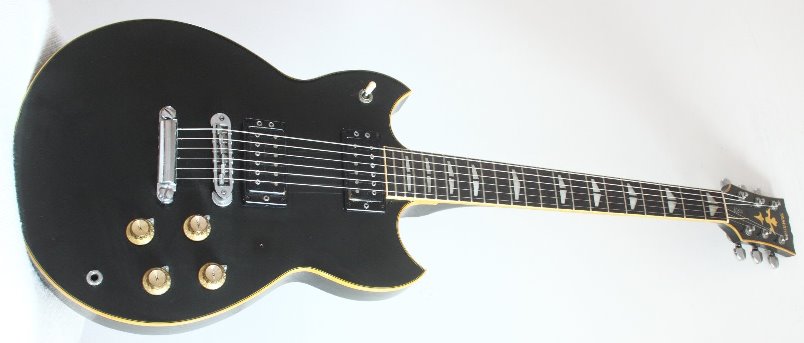

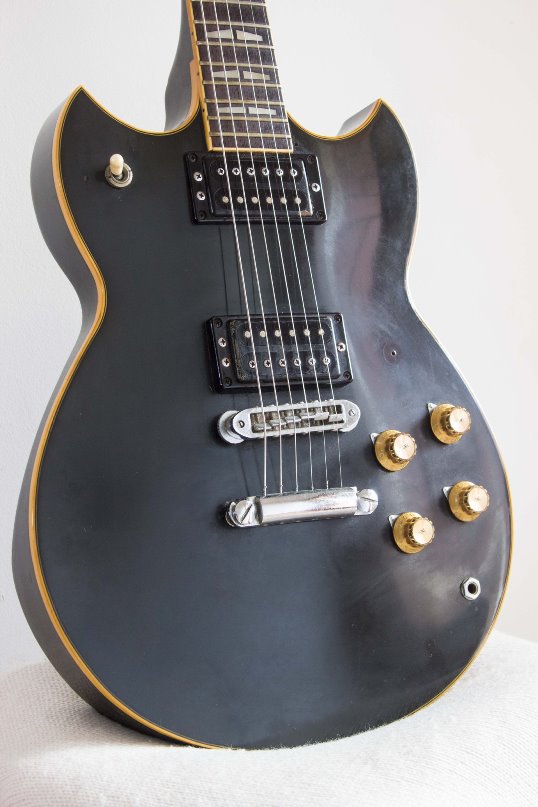

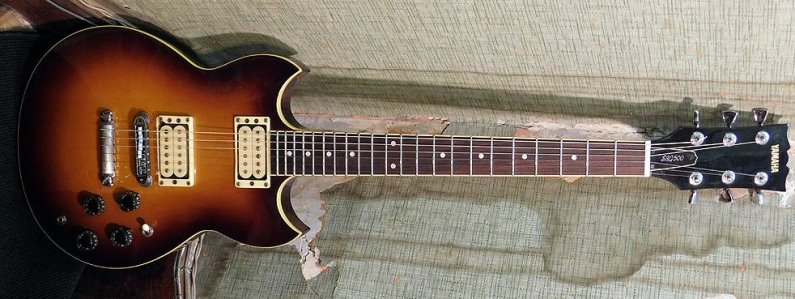
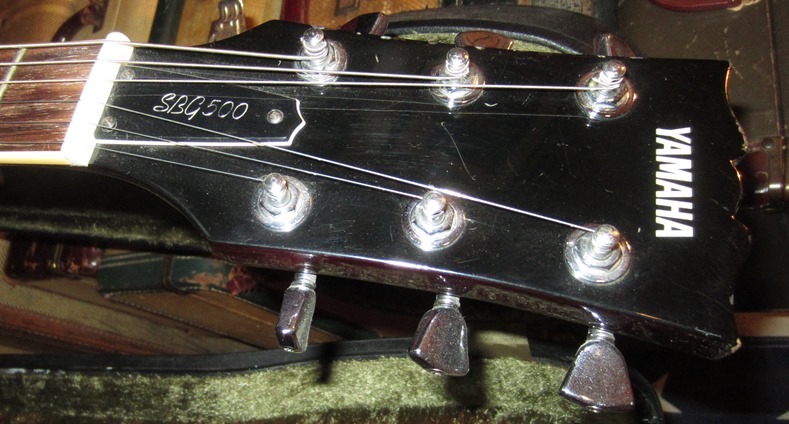
This is one step up from the 500 having different body wood and a coil split via push push tone knobs.
Again lasted until about 1979.
In January 2020 a 700 sold on ebay auction for £627 otherwise these are not often seen.
There is an SG700S released in 1997 details on separate page.
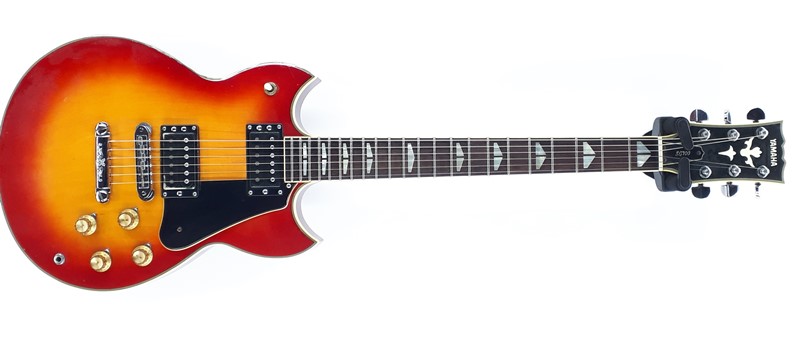


This is quite a long lived model with some variations along the way. The last mention I can find is in the 1988 US
catalogue where it is styled as SG not SBG. More on this later. There is a reissue of the SG1000 in 1996. It is however styled as the SG1996.
Described as a reissue of a timeless classic brought up to date.
In the 1982 Japanese catalogue there is a black model a new colour.
At various points Left handed models are available as special order.
In 1987 it is back as the SG1000 with the tone bypass circuit
The last appearance I can find is in the 1988 Western Catalogue styled as the SG1000 it has had some changes it now has
Spinex pickups, a 350mm radius is mentioned and the colours are now Black, Brown Sunburst or Cream White.
It continued in Japan as a domestic only model until at least 1996
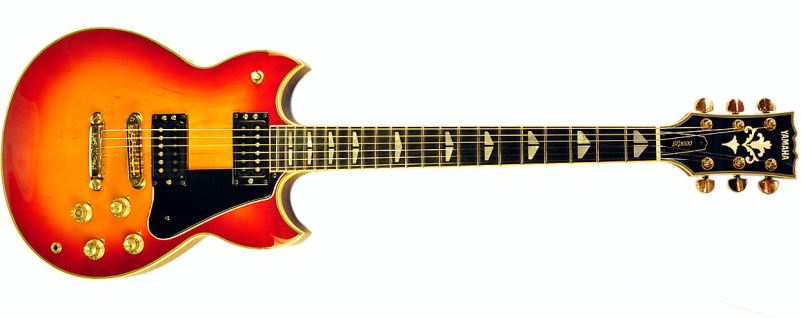

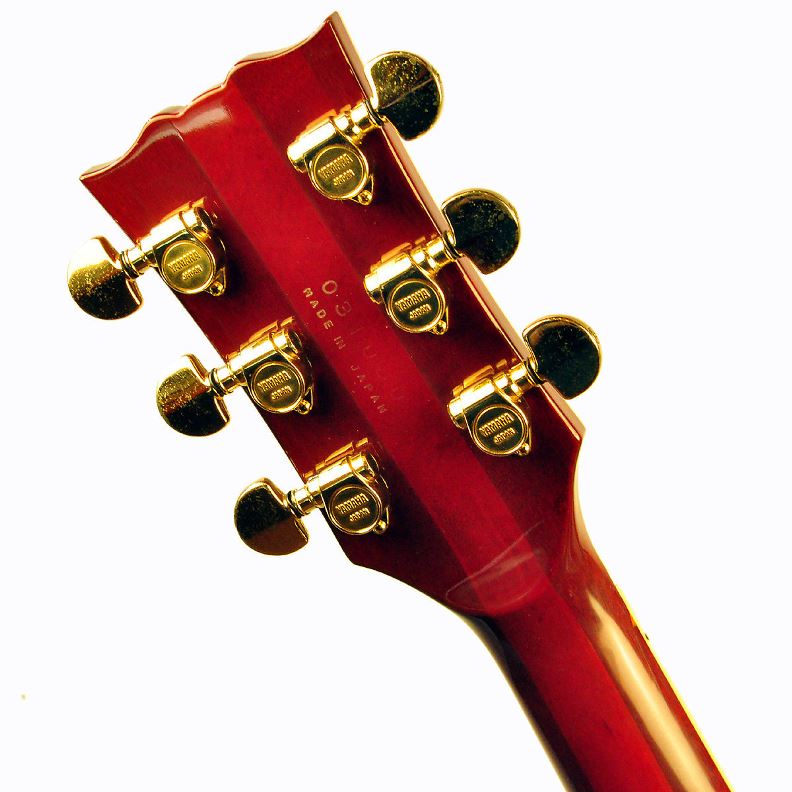

In the early 80s a variation appears it is the 1000S this is very similar to the 1000 with Just the following differences
| 1000 | 1000S | |
| Headstock | Complex binding see picture above | Simple binding see picture below |
| Neck | Maple and Mahogany Set | Mahogany Set |
| Board | Bound Ebony Split Pearl Inlays | Rosewood Split Inlays |
| Colours early 80s | Red Sunburst or Brown Sunburst | Red Sunburst or Black |
| Tone Bypass circuit | Yes | No |
The SBG1000 appearing in the catalogues at the time is an SG1000S not an SG1000

The joys of trying to document Yamaha guitars. The SG1500 is 2 different guitars. The first version has the specs
listed above, production ceased around 1979/80. It could be I am missing something but I can't see it in any Japanese catalogues
so maybe it is an export only model. Some similar features to the SG2000 having the same body construction and the brass sustain plate.
It does however have a set neck rather than a through neck.
The second SG1500 is launched in the 1982 Japanese catalogue as a new model with very different specs. Domestic Market only.
It is relatively short lived from the pictures I have seen and from what I have read it appears to be:
Body Mahogany
A through neck one piece with the body
Gold Hardware
No brass sustain plate
Coil Tap by push push tone controls
No Pickguard (possibly optional)
Chevron Markers on the rosewood fretboard
Headstock with binding like the 2000
Colours Old Sunburst, Persimmon Red or Jade Green
A really nice looking SG



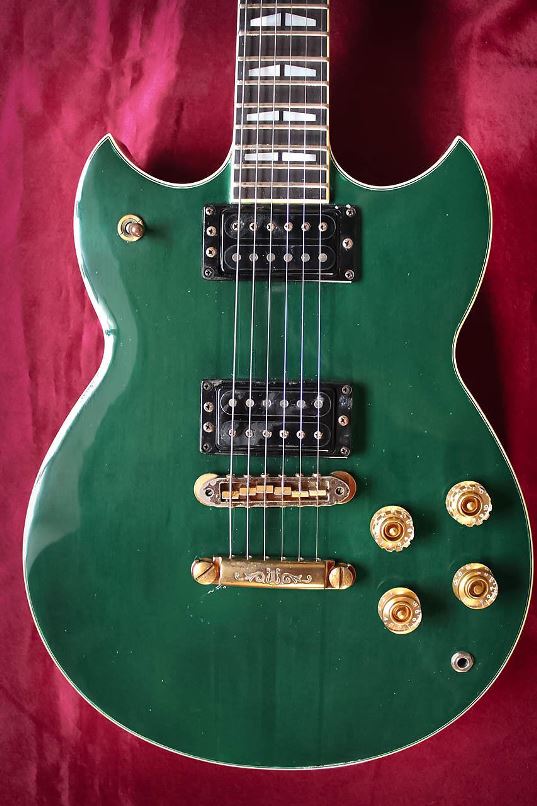

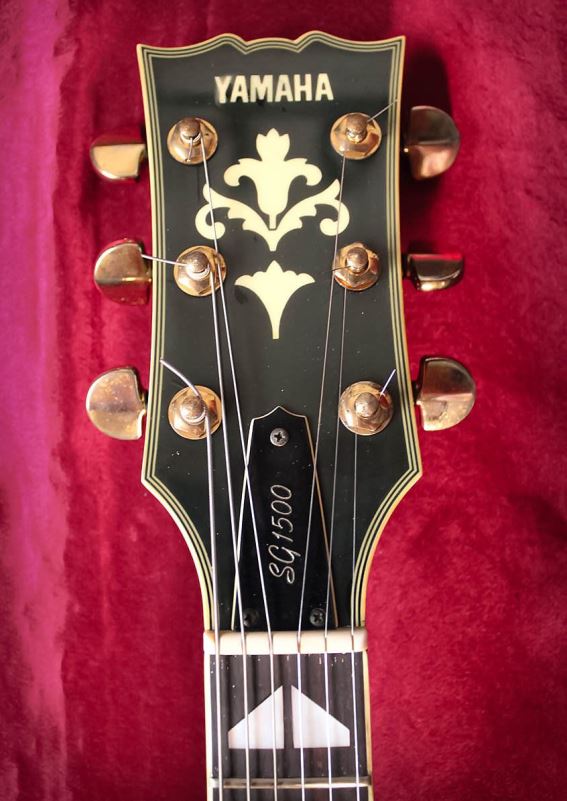
What can you say that's not already been said this is everything a Yamaha SG should be it is the model that
everyone wants and at the time as good a guitar as any you could buy for the money or a whole lot more money.
There is a brass sustain plate under the bridge.
One sold this year (2022) for £1420 and I have seen them for quite a bit less on Ebay.
Changes and Evolution the SBG and the S model
General
The first significant universal change occurs around 1980 when a coil split is added using push push tone controls.
Domestic the Japanese Catalogues
At launch in 1976 it was 150000 yen but for an extra 18000 yen you could have a hard case
It dipped in and out of the catalogues but was probably always available.
Around 1987 it is now part of the traditional range and as well as the original Sunburst colours it was now available in
Cream White or Black. It now has Spinex pickups.
In 1992 there is only a Weddington version identical to the Yamaha branded version except no Cream White.
1995 the Yamaha branded version is back still no Cream White
Carries on unchanged until at least 2001
The Western Catalogues
In the 1980 USA catalogue there is an SBG2000 and an SG2000. The SGB 2000 has the coil split the SG2000 doesn't.
They are otherwise the same even down to the same colour options as shown above.
In the 1982 catalogue and the 1985 catalogue it is the SG2000S, essentially the same specs but colour options are
Deep Green, Cherry Sunburst or brown Sunburst.
The last appearance I have of it is in the 1988 USA catalogue where all are referred to as SG not SGB it is
back to being just the SG2000 but like the 1000 of the time now has Spinex pickups, mentions a 350mm radius and
has colour options of Black, Brown Sunburst or Cream White.
A comment from Leon
Leon is the host of Yamaha Vintage Guitars see my links
The SG1000, as well as some other SG's, were a complete 'mess' in the early 80'ies. Yamaha kept changing, sometimes only
for a part of the world. The SG1000S only appears in the EU catalogs in the years 82, 83 and 84. The US catalogs keep the SBG1000.
Japanese keep the SG1000. Yamaha also made some changes to the SG1000, thinner body and open pickups in 1982. Seems the changes are
only mentioned in the US catalogs (perhaps also in Japan but I can't read those 8) ). So perhaps only the SBG1000's have the thinner body.
Don't know whether the body got normal again somewhere after that. After 1984 the SG1000S became the SG1000 again.





A word about SG and SGB
Conventional wisdom is that Gibson objected to Yamaha using the SG designation in the USA so Yamaha used SGB.
This may be the case but I am sure there is more to it than that. The book "The history of Yamaha Guitars" claims that
this happened in the mid 1980s which is plainly wrong as the term appears in the 1980 catalogue.
The SBG500 and The SG500 both appear in western catalogues at the same date see above but are completely different guitars. The
SG models and SGB models appear in the same 1980 USA catalogue. There are subsequent USA catalogues that refer to SG.
None of this makes sense and why only in the USA surely Gibson would have asked to alter it worldwide as they are a worldwide brand.
All a bit mysterious.
Some observations from Leon
On your SG and SBG thoughts:
1980 is the first year there are SBG's in the catalogs. Before that it's only SG. After that in most cases there are two almost
identical catalogs. One saying SG, one saying SBG. Yamaha uses a specific numbering system at the back of the catalogs. From 1982
on all catalog number with ths SBG's end with "U". I assume this stand for USA. All the European and Japanese catalogs say SG. I
think there are a lot of catalogs, not indicated by the "U", that were both for Europe and The US. Don't know for other parts of
the world. I even have a 1981 catalog that presents both the SBG's and the SG's next to each other. After that until the end of
the SG's there are some years with two almost identical catalogs every year , one with the SG's and one with the SBG's. The ones
with the SBG's always seem to have the "U". Sometimes the European catalogs have some extra guitars. Seems some models were exported
to Europe but not to the US.